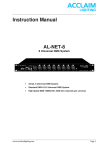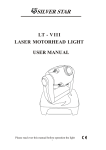Download 140191.MANUAL DE INSTRUCCIONES CUARZO-RUBI
Transcript
MANUAL DE INSTRUCCIONES 1. CARACTERÍSTICAS TÉCNICAS ∗ Alimentación: 6 Voltios. Cuatro pilas modelo AA, R6 o equivalente. Utilice pilas alcalinas. Observe el periodo de caducidad de las pilas antes de instalarlas en la caja. No utilice pilas recargables. ∗ Códigos de longitud variable de 2 a 15 dígitos. ∗ Sistema de bloqueo automático de 5 minutos al introducir una combinación errónea más de 10 veces consecutivas. ∗ Sistema de aviso de pilas bajas. ∗ Circuito dotado de una memoria E-EPROM que permite almacenar todos los datos durante más de 40 años, sin necesidad de estar conectadas las baterías. ∗ Dispositivo combinado de “led’s” y “beep’s” de señalización auditiva y visual, para el uso de invidentes y sordos. ∗ Las pilas nuevas permiten aproximadamente 5.000 aperturas. Recomendamos cambie las pilas cada año. Deseche las pilas gastadas de forma respetuosa con el medio ambiente. ∗ Dispone de un código de usuario para apertura normal, más un código para APERTURA DE EMERGENCIA ∗ Dispone de una LLAVE DE EMERGENCIA. ∗ Conexión para alimentación externa que permite la apertura frente al agotamiento de pilas. ∗ Programación de retardo en el código de usuario, de 0 a 99 minutos. ∗ Iluminación en el interior mediante LEDs de bajo consumo. Antes de cualquier actuación lea atentamente las instrucciones y la garantía. 2. PRIMERA UTILIZACIÓN Importante: Junto con la documentación se incluye un adhesivo que indica el número de su caja fuerte. Coloque este adhesivo en la puerta, el número de caja es fundamental para solicitar aperturas de emergencia, repuestos, etc. 2.1 Si su caja está cerrada, ábrala con la llave de emergencia que hay en el sobre adjunto (apartado 5). 2.2 Si su caja tiene algún impedimento (cartón, celofán, etc.) en la parte de los cerrojos, retírelo. 2.3 A continuación coloque las cuatro pilas alcalinas (no utilice pilas recargables) en el compartimento interior de la puerta, según las instrucciones de cambio de pilas (apartado 7). 2.4 Abra y cierre la caja varias veces (apartado 3). 2.5 Cambie el código de usuario original (apartado 4). ¡IMPORTANTE! Realice todas las comprobaciones con la puerta abierta, antes de proceder al cierre de la caja. 3. INSTRUCCIONES DE APERTURA/CIERRE Introducir la llave y proceder del modo siguiente: 3.1. Marcar los números de la combinación. Al salir de fábrica, las cajas tienen la combinación 1 2 3 4 5 6. Con cada pulsación oirá un “beep” y se encenderá la luz roja. En el caso de que no marque ninguna tecla durante 7 segundos, se desactivará el sistema; en este caso, volver al principio. 3.2. Si la combinación es correcta, se iluminará la luz verde y usted dispondrá de 5 segundos para girar la llave, mientras dicha luz permanece encendida. Si se apaga la luz, vuelva al punto 3.1. 3.3. Para cerrar, gire la llave. Ejemplo de apertura: 1 2 3 4 5 6 ¡IMPORTANTE! Nunca deje la llave puesta en la caja. 4. PROGRAMACIÓN/CAMBIO DE COMBINACIONES A. Código de usuario: Todas las cajas salen de fábrica con la misma combinación. Por su seguridad no olvide cambiarla. A.1. Abrir la caja con el actual código de usuario (apartado 3). A.2. Pulsar la tecla “#/Reset”. Se iluminará la luz roja, y sonará el tono de programación. A.3. Introducir el código de usuario actual (de fábrica, el 1 2 3 4 5 6). Con cada pulsación se iluminará la luz roja, y sonará un “beep” corto. Si el código es correcto, sonará el tono de programación. A.4. Introducir el nuevo código (de 2 a 15 dígitos), seguido de la tecla “C”. Sonará el tono de programación. A.5. Volver a introducir el nuevo código para confirmar. Si es correcto sonará el tono de programación, y se iluminará la luz verde, indicando que ya podría cerrar la caja. Si no es correcto sonará el tono de error y deberá volver al punto A.2. A.6. Con la puerta abierta realice al menos tres comprobaciones, siguiendo las instrucciones de apertura, para asegurarse que su nueva combinación es correcta. Ejemplo de programación: A.1. 123456 A.2 #/Reset A.3. 1 2 3 4 5 6 A.4. 9 7 6 1 0 8 0 8 8 C A.5. 9 7 6 1 0 8 0 8 8 (abrir con actual código de usuario) (pulsar tecla “#/Reset”) (código actual) (código nuevo + tecla “C”) (repetir el codigo nuevo) B. Código de emergencia: Cada caja sale de fábrica con un código de emergencia exclusivo. Recomendamos no cambiarlo, pero en el caso de desear hacerlo siga la siguiente secuencia: B.1. Abra la puerta con el código de emergencia (ver apartado 5 y sobre adjunto): B.2. Pulsar la tecla “#/Reset”; se iluminará la luz roja, y sonará el tono de programación. B.3. Introducir el código de emergencia actual (de fábrica, el indicado dentro del sobre adjunto). Con cada pulsación se iluminará la luz roja, y sonará un “beep” corto. Si el código es correcto, sonará un tono de programación. B.4. Pulsar la tecla “2”. B.5. Pulsar “#/Reset”; se iluminará la luz roja, y se oirán 2 tonos cortos. B.6. Introducir el nuevo código (de 2 a 15 dígitos), seguido de la tecla “C”. Sonará el tono de programación. Cód. 140191. Rev.11/12; www.btv.es; [email protected]; Servicio asistencia técnica: 902 190 386 B.7. Volver a introducir el nuevo código para confirmar. Si es correcto sonará el tono de programación, y se iluminará la luz verde, indicando que ya podría cerrar la caja (en los modelos con motor el cierre se efectua automáticamente). Si no es correcto sonará el tono de error y deberá volver al punto B.2. B.8. Con la puerta abierta realice al menos tres comprobaciones, siguiendo las instrucciones de apertura, para asegurarse que su nueva combinación es correcta. Ejemplo de programación: B.1. 87654321 B.2. #/Reset B.3. 87654321 B.4. 2 B.5. #/Reset B.6. 976108309C B.7. 976108309 (abrir con el actual código de emergencia) (pulsar tecla “#/Reset”) (actual código de emergencia) (pulsar la tecla nº “2”) (pulsar la tecla “#/Reset”) (nuevo código de emergencia + “C”) (repetir el nuevo código de emergencia) ¡ATENCIÓN!: Si se salta los pasos B.4 y B.5 modificará siempre el código de usuario. NOTA: Recomendamos que programe siempre números sencillos de recordar, como por ejemplo números de teléfonos de amigos, fechas de nacimiento, matrículas de vehículos, etc., y sobre todo… no confíe en la memoria y escriba la nueva combinación en algún lugar secreto. 5. APERTURA DE EMERGENCIA Junto con la caja se suministra un sobre que contiene: 5.1. Una llave mecánica de emergencia, que va a permitir abrir la caja en los casos de anomalía electrónica, pilas agotadas, olvido de la combinación programada, etc. Introduzca la llave de emergencia (llave dorada) en la cerradura, gírela hacia la derecha hasta el tope. Vuelva a girar la llave de emergencia hacia la izquierda y sáquela. A continuación introduzca la llave de usuario, gírela hacia la derecha y abra la puerta. 5.2. Un código de emergencia, para abrir la caja en caso de olvido de su código habitual. Para abrir con este código de emergencia, introduzca el número tal y como hace con el código habitual. La luz verde se iluminará, indicando que puede efectuar la apertura. Por su seguridad, este código no debe cambiarse. Si necesita cambiarlo siga lo indicado en el apartado 4.B. MUY IMPORTANTE: Ha recibido un sobre con la llave y el código de emergencia para su caja. Nunca guarde este sobre, o sus componentes, dentro de la caja fuerte. 5.3. Conexión de alimentación exterior para efectuar aperturas de emergencia en caso de pilas agotadas. Para ello, coloque una pila alcalina de 9V (tipo 6F-22 S) en el lugar indicado en el teclado, respetando la polaridad indicada. A continuación, y manteniendo la pila en ese punto, introduzca su código y efectúe la apertura como normalmente. Tras abrir la caja, cambie todas las pilas por cuatro pilas alcalinas nuevas. 6. PROGRAMACIÓN DEL RETARDO DE APERTURA Esta función activa un retardo que bloquea la apertura de la caja durante 1 a 99 minutos desde el momento que se teclea el código de usuario. Durante el tiempo que dura el retardo parpadea la luz roja y no se puede abrir la caja. Al pasar el tiempo establecido el sistema desbloquea el cierre, emite un pitido corto y permite la apertura de la caja durante 5 segundos. Para activar o desactivar esta función, la puerta debe estar abierta. a) Para activar esta función: 1. Pulsar la combinación “C 1 0 0”, en ese momento se oirá el tono de programación y se iluminará la luz roja. 2. Teclear el número de minutos (de 1 a 99) que quiere fijar como retardo; volverá a sonar el tono de programación. 3. En los modelos con llave, reintroducir el número de minutos de retardo para confirmar. Ejemplo de programación de un retardo de 3 minutos: 1. C 1 0 0 (Pulsar la combinación “C 1 0 0”). 2. 0 3 (Número de minutos de retardo: 3) 3. 0 3 (Confirmar el número de minutos de retardo) b) Para desactivar la función: sólo tiene que programar de nuevo el retardo con un tiempo de 0 minutos: 1. 2. 3. C 1 0 0 0 0 0 0 (Pulsar la combinación “C 1 0 0”). (Número de minutos de retardo: 0). (Confirmar el número de minutos de retardo: 0) 7. OBSERVACIONES ∗ Código erróneo: si el código que marca no es el programado anteriormente, oirá un tono especial que indica que este código no es el correcto. Vuelva al punto número 1 de las instrucciones de apertura. ∗ Bloqueo: el sistema de bloqueo automático le proporciona seguridad adicional contra el robo, ya que al introducir 10 veces seguidas una combinación errónea, la caja queda bloqueada durante 5 minutos. Durante este tiempo, la luz roja parpadeará, y será imposible la apertura de la caja. Al finalizar este tiempo, podrá abrirla siguiendo el procedimiento habitual. ∗ Pilas bajas: este sistema detecta que el nivel de las pilas empieza a ser demasiado bajo, y que es el momento de cambiar las cuatro pilas, aunque la caja todavía permitirá unas 100 aperturas. Usted reconocerá esta indicación por los tonos largos que emite la caja al pulsar cualquier tecla, acompañados de la luz roja intermitente. ∗ Cambio de pilas: al portapilas se accede desde el interior de la caja, en el reverso de la puerta. El portapilas se encuentra bajo una tapa. Abra la tapa. Una vez abierta, cambie las CUATRO pilas (no deje ninguna pila antigua). No utilice pilas recargables. Cierre de nuevo la tapa, y verifique el correcto funcionamiento antes de cerrar. Cód. 140191. Rev.11/12; www.btv.es; [email protected]; Servicio asistencia técnica: 902 190 386 OPERATING INSTRUCTIONS 1. TECHNICAL FEATURES Power supply: 6 Volts (4 batteries, type AA, R6 or equivalent). Alkaline batteries recommended. Do not use rechargeable batteries. Codes from 2 to 15 digits. Automatic blocking system for 5 minutes when more than 10 consecutive incorrect codes are entered. Low batteries’ warning system. E-EPROM memory circuit, which stores data for more than 40 years, with no need to have it connected to the batteries. User friendly signalling system, makes its use easy and convenient for handicapped. More than 5.000 openings with new batteries. Replace the batteries every year for correct functioning. Replace the batteries every year for correct functioning. Respect the enviroment. Do not throw the batteries in the garbage. ∗ One user code plus one EMERGENCY CODE. ∗ Emergency key provided. ∗ External power supply to open your safe in case the batteries are completely discharged. ∗ User code delay function: 0 to 99 minutes time delay. ∗ Keep the identification number plate on the safe, this will allow opening service, spare components, etc. ∗ Interior light with 2 low consumtion leds. Read carefully these instructions and warranty before any action. ∗ ∗ ∗ ∗ ∗ ∗ ∗ ∗ 2. FIRST USE Important: You have received with the documents an identification number plate. Put this plate on the door. The identification number allow opening service, spare componentes, etc. 2.1 If your safe is closed, open it with the emergency key you will find in the enclosed envelope (point 5). 2.2 If you find some drawback such as celofan, cardboard… next to the bolts, please remove it. 2.3 Next, fit the four batteries (do not use rechargable batteries) as indicated on instructions manual (point 7). 2.4 Then open and close the safe several times (point 3). 2.5 To follow properly, you should change the original user code for your own one (point 4). IMPORTANT! Check all those points with the door open, before closing it. 3. OPENING/CLOSING INSTRUCTIONS Introduce the key and follow the next steps: 3.1. Introduce your code number. All the safes have the code 1 2 3 4 5 6 programmed when used for the first time. After you press each digit, there will be a short beep and the red light will turn on. If you do not press any key for 7 consecutive seconds, the unit will disconnect; in this case, start again from step the beginning. 3.2 If the code entered was correct, the green light will turn on; you will then have 5 seconds to turn the key, while this light stays on. If the green light turns off and you did not open the safe yet, go back to step 3.1. 3.3 Turn the key to close the door. Opening example: 1 2 3 4 5 6 IMPORTANT! Do not ever forget the key in the key hole. 4. PROGRAMMING OR CHANGING YOUR CODE A. User code: every safe has been programmed with equal code. For your security do not forget to change it. A.1. Open your safe with the current code (point 3) A.2. Press the key “#/Reset”. The red light will turn on and a programming tone will be heard. A.3. Introduce your current code (from the factory, the number 1 2 3 4 5 6 ). After you press each digit, there will be a short beep and the red lignt will turn on. If the code is correct, you will hear the programming tone. A.4. Enter the new code (from 2 to 15 digits), followed by the key “C”. After this, you will hear again the programming tone. A.5. Finally, introduce again the new code, so as to confirm it. A programming tone will be heard, and the green light will turn on, indicating that the new code has been programmed, and it is now possible to lock the safe (in motorised models, once you have closed the door, the bolts will lock automatically). If the programmation was not corretly done, you will hear the error tone and you should star from point A.2. A.6. Before closing the door, check the new code at least three times, following the opening instructions. Example of programming: A.1. 123456 A.2. #/Reset A.3. 123456 A.4. 976108088 C A.5. 976108088 (current code to open the safe) (press the key “#/Reset”) (introduce current code) (introduce new code + key “C”) (repeat the new code) B. Emergency code: every safe has been programmed with a different emergency code. We recommend you not to change it, but if you wish to make it, follow the next sequence: B.1 Open the door with your emergency code (see point 5, and the enclosed envelope). B.2 Press the key “#/Reset” the red light will turn on and a programming tone will be heard. B.3 Introduce your current emergency code (from the factory, the one in the enclosed envelope). If the code is correct, you will hear the programming tone. B.4 Press the key “2”. B.5 Press the key “#/Reset”; the red light will turn on and two short beeps will be heard. B.6 Enter the new code (from 2 to 15 digits) followed by the key “C”. After this, you will hear again the programming tone. Cód. 140191. Rev.11/12; www.btv.es; [email protected]; Servicio asistencia técnica: 902 190 386 B.7 Finally, introduce again the new code, so as to confirm it. A programming tone will be heard, and the green light will turn on, indicating that the new code has been programmed, and it is now possible to lock the safe. If the programmation was not correctly done, you will hear an error tone; in this case, return to step B.2 B.8 Before closing the door, check the new code at least three times, following the opening instructions Example of programming: B.1. 87654321 B.2. #/Reset B.3. 87654321 B.4. 2 B.5. #/Reset B.6. 976108309 C B.7. 976108309 (open with the current emergency code) (press the key “#/Reset) (introduce current emergency code) (press the key “2”) (press the key “#/Reset) (introduce new emergency code + key “C”) (repeat new emergency code) BEWARE!: If you omit steps B.4. and B.5., you will modify the user code. NOTE: We strongly suggest that you program code numbers which are easy for you to remember, such as friends’ telephone numbers, birth dates, car licence plates, etc.. Do not trust memory, and do write your code number in a secret place. 5. EMERGENCY OPENING Your safe is provided with an envelope which contains: 5.1. One mechanic emergency key, which will allow you to open the safe in case of electronic anomaly, discharged batteries, forgetting of the code number programmed, etc. Introduce the emergency key (golden key) in the keylock. Turn the key to the right , then, turn the key to the left and take it off. Then, introduce the user key, turn to the right and open the door. 5.2. One emergency code number to open your safe in case that you have forgotten your normal opening code number. Enter your emergency code number as usual. The green light will turn on, showing that you can now open your safe. For your security the emergency code should not be changed. If you need to , do as explained in point 4.B. VERY IMPORTANT: You have received the emergency key and emergency code for your safe in an envelope. Do not ever keep this envelope or its components inside your safe. 5.3. External power supply, to open your safe in case the batteries are completely discharged. To use it, put an alkaline 9V battery (6F-22 S type) against the two black dots in the keypad, watching out that the polarity is correct. Then, while holding the 9V battery on the keypad, introduce your code number, and open your safe as usual. Do not forget to replace all four batteries for new ones, as soon as you have opened your safe. 6. OPENING DELAY PROGRAMMATION This function activates a delay which blocks the opening of the safe for 1 to 99 minutes after the user code has been entered. The red light flashes during the delay time, and when it is over, a short beep will be heard, the system unblocks and allows the opening of the safe for 5 seconds. To activate or discativate this function, the door must be in the open position. a) To activate this function: 1. Enter the following secuence: “C 1 0 0”. The red light will turn on and you will hear the programming tone. 2. Introduce the desired delay number of minutes, from 1 to 99. You will hear the programming tone. 3. In models with key, introduce again the number of minutes, so as to confirm it. 3 minutes delay programming example: 1. C 1 0 0 (Enter the sequence “C 1 0 0”) 2. 0 3 (Number of delay minutes: 3) 3. 0 3 (In models with key, confirm the number of delay minutes) b) To desactivate this function: just program the delay with 0 minutes time. The sequence is: 1. 2. 3. C100 00 00 (Enter the sequence “C 1 0 0”) (Number of delay minutes: 0) (In models with key, confirm the number of delay minutes) 7. OTHER FEATURES Incorrect code number: if the code number that you have entered is not the one programmed before, you will hear a special tone indicating that this code number is not correct. In this case, go back to step 1 of opening instructions. Blocking system: provides aditional security. If incorrect code numbers are entered more than 10 times consecutively, some long beeps will be heard, and the safe will stay locked for 5 minutes. During this time, the red light will be flashing and it will be impossible to open the safe. When the 5 minutes have gone by, you will be able to open the safe as usual. Low batteries: The system detects whether the batteries are very low. If this is the case, you will hear some tones followed by the flashing red light when you press some key: you will still be able to operate your safe around 100 times, but it is hightly recommended that you change all four batteries at the time. Replacement of batteries: The batteries’ holder can be found in a comparment inside the door, under a small cover. Once you have removed the cover, change all four batteries (do not use rechargable batteries) for new ones and secure the cover back. Check the right functioning of the safe before locking it. Cód. 140191. Rev.11/12; www.btv.es; [email protected]; Servicio asistencia técnica: 902 190 386




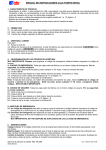
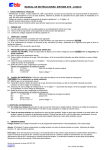
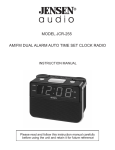

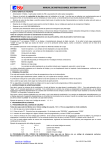



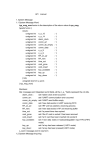




![IL 2.003.01 [Delta MK2]e-pag1.ai](http://vs1.manualzilla.com/store/data/005753338_1-488e124ad81f3853ba4b74f093f13849-150x150.png)
